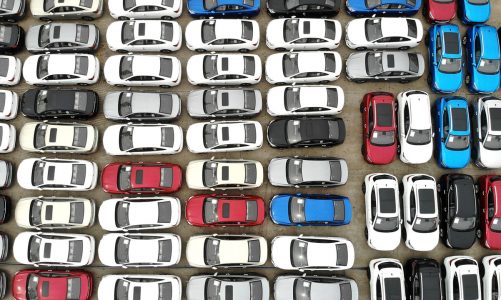The video was frank, narrow, shaky and without fanfare; his early paintings captured not much more than asphalt. But in the span of 14 minutes, Trevor Milton, the founder and CEO of Nikola Motor, a Phoenix startup committed to making electric semi-trailers, motivated investors enough to boost his company’s stock by 35%. In a day.
The clip reveals a hydrogen fuel cell electric semitrailer rolling through an extremely hot Arizona parking lot. Milton runs after the van on foot, pointing out the various components of its unusual powertrain and lashing out at critics who believe the company’s technology is bogus.
Entrepreneurs, and the investors behind them, are convinced that replacing greenhouse gas-emitting diesel trailers with cleaner electric versions is a great opportunity to turn a profit while making the world a better place.
“There’s a lot of buzz and excitement,” says Ben Hartford, a Baird equity analyst focused on logistics.
The American Trucking Associations like to say that industry is the lifeblood of the American economy, and they are right. Freight trucks carry nearly 73% of all cargo transported in the US But those vehicles are still overwhelmingly powered by fossil fuels. Medium- and heavy-duty trucks account for about 6.4% of all US greenhouse gas emissions, according to the US Environmental Protection Agency.
To reduce their contribution, truck operators would have to spend a lot of money on cleaner trucks. There was strong momentum in June with a new California regulation requiring that, starting in 2024, at least 5% of medium and heavy duty trucks sold in the state produce zero emissions. (The share increases to 30% in 2030, then 100% in 2045. Short-haul trucks, which are used to deliver cargo between ports, rail yards, and warehouses, are subject to an even more aggressive schedule.) Given that the state has unique influence in this area – a dozen states have adopted California’s motor vehicle emissions regulations – the pressure could quickly mount for truck operators.
Regulation is not the only factor driving electrification. Elon Musk’s Tesla, which has promised to deliver its own electric truck in 2021, says a battery-electric truck costs about half as much fuel per mile as its diesel counterpart. The maintenance costs of electric trucks are also expected to be lower because they have fewer moving parts.
Newcomers face a tough challenge from established truck manufacturers. Toyota, the world’s largest automaker by sales, and Peterbilt of Paccar, the second-largest semi-finished manufacturer behind Daimler-owned Freightliner, have publicly committed to a future of zero-emission trucks. In the United States, Volvo and Freightliner have put dozens of electric trucks to the test on the road. Like Nikola and Tesla, the goal is to start selling them next year.
“How do you integrate into a fleet? How does charging work? We’re trying to figure out the practical stuff, ”says Keith Brandis, Volvo’s business development executive.
Midsize truck and warehouse operator NFI Logistics has been operating 10 Freightliner electric trucks in California for nearly a year as part of a pilot program. NFI will soon add trucks from Volvo’s program, called Lights, which launched its first test trucks in June. Bill Bliem, head of fleet services at NFI, says his company’s main motivator for leading electric truck charging is its commitment to sustainability.
In their current form, electric trucks have a key deficiency: limited range from their diesel counterparts. Tesla, for example, says its top-end model will go 500 miles on a single charge, compared to 800 miles for a diesel truck on a tank of fuel.
So electrification occurs first on short-haul routes. NFI is using its Freightliner test trucks to deliver cargo from the ports of Los Angeles and Long Beach to its warehouses in East Los Angeles, a 100-mile round trip.
The cost advantage of hydrogen electric trucks, like the Nikola Two in Milton’s video, is less clear. Refueling with liquid hydrogen is faster than recharging a battery, and hydrogen can carry more energy for its weight than a battery, more practical for long-distance transport. But liquid hydrogen fuel, which is produced by using electricity to split water into oxygen and hydrogen, is generally more expensive than charging batteries directly.
Speaking of expensive, almost everyone agrees that electric trucks will cost more than diesel trailers, which can cost up to $ 150,000. So far, Tesla is the only manufacturer to have hinted at a price, saying its electric trucks will start at between $ 150,000 and $ 200,000. Other manufacturers are expected to charge more because Tesla is believed to produce batteries for less than its competitors.
Nikola plans to use a different business model for its hydrogen fuel cell semis. Rather than selling trucks, he plans to lease them as part of a package that includes hydrogen fuel and maintenance.
And then there’s the cost of building new charging stations, necessary when it can take several hours to recharge a large truck’s battery. While some states, for example California, offer grants to soften the financial blow, others do not.
That is a deciding factor for many operators. Out of an estimated 1.9 million US trucking companies, up to 94% have fleets of 20 trucks or fewer. Additionally, approximately 9% of all truckers are independent owner-operators who drive a truck they own. Smaller operators simply cannot afford the considerable investments that would be required to go electric, says Glen Kedzie, who leads energy and environmental policy issues at American Trucking Associations.
Although operators have years before being forced to give up diesel trucks, the dynamics of the electrification market is already catching up. “It starts raising the barriers to entry for the smallest carrier,” says Baird’s Hartford. Next stop: consolidation of a fragmented industry.
As long as your startup doesn’t try to turn it around, sure. Nikola’s Milton says he understands the skepticism about his company’s prospects, but notes that automakers said the same about Tesla early on. “Now Tesla is worth more than most of them put together,” he says. “We don’t mind being the underdog.”




